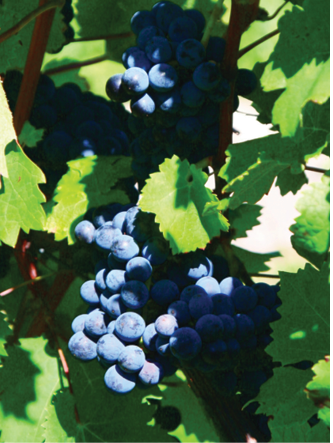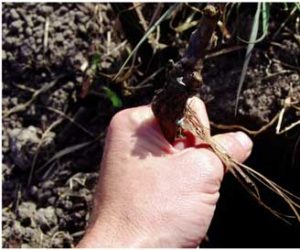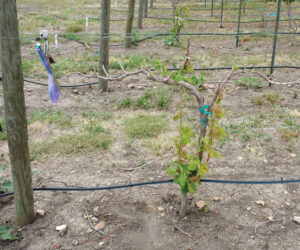Wes Hagen, our “Backyard Vines” columnist for the last 13 years, answers questions in the magazine at least once per year. He’s happy to
take questions anytime via email at [email protected]. If at all possible, please include pictures, the location of the vineyard, soil type, varietals and the number of vines. Wes tries to answer all of the questions sent to him, and those he deems most helpful to the general viticulture community are sometimes published.

Wes answers: First, I look forward to seeing you in Virginia in June. I hope you’ll come and join us at the annual WineMaker Magazine Conference being held in Leesburg, and please sign up for my full-day Backyard Vineyard Boot Camp. Lots of discussion, no push-ups or unnecessary exercise, I promise.
As many of my readers know, I’m a huge fan of Norton in the Midwest and East Coast, and have tasted very good Cabernet Franc from your state. I believe Cab Franc expresses itself in a more balanced and delicious fashion than Cabernet Sauvignon in many climates outside of Napa, Sonoma, and Washington State. I am impressed with your blending choice too. Many would be hesitant to blend hybrids and vinifera, but I expect you make a superior wine because of your decision. Norton will also hedge your bet in tough years when the Cab Franc just can’t be harvested clean or ripe. So good choices!
Specifically addressing your question, I use a combination of tests, anticipated weather patterns and flavors to decide when to harvest. Because I am lucky to grow grapes in an area that rarely sees measurable rainfall between April and October, we can wait for optimal ripeness. If you see a fall storm approaching that may dump inches of rain; that can be a huge motivation for picking. In a perfect world you would like to see 24+ °Brix and a pH around 3.4-3.6, which will translate into a candy-like sweetness with some good structural acidity. Here’s a good pro trick: I like to take careful tasting notes on juice from my field sampling. In a backyard vineyard, you can’t take 10 pounds of fruit each time you sample, so take berry samples. Walk through the rows with a small Ziploc bag and take berries from different parts of the cluster until you have about 40-50 berries.
Crush them in the bag and use the juice for a sample, or let the wet mess ‘soak up’ 24 hours to see if the numbers change. Pay special attention to Brix bumps and pH shifts, as these will also influence harvest decisions. Taste the juice and make notes. Are the flavors bright and light? Cherry? Apple? Kiwi? Blackberry? Cassis? You want to wait until you lose the aromas and flavors that are generally associated with white wine. I get apple aromas in unripe red grapes commonly, even aromas of kiwi, so wait until the aromas in the juice ripen to the point where the aromas are pleasant and enticing. A light generally goes off in my head when I taste the grapes and they are ready. I also keep detailed notes on juice references (e.g. cherry, apple, blackberry) so I can correlate what I tasted in the unfermented juice with the wine I made from the fruit. Ten years of this type of note taking will give you a library of anticipated flavors and styles, and will help a lot.
As far as harvesting vinifera (Cab Franc) vs. hybrids (Norton), I would be much more worried about vinifera rotting or having fungal issues, so I would be more likely to pull the trigger earlier on vinifera, and going for higher ripeness in the Norton.
Also pay attention to seed color and flavor. You don’t want to pick until the slimy pulp detaches from the seed. I also look for the seed to turn at least 50% nut brown, and when you chew the seed it should be crunchy and pleasant. Those are my tricks; I hope they serve you well.
Ellen P. in Atascadero, California writes: We have 200 Zinfandel vines on a slight slope in our large backyard in Atascadero. We understand that the best wine in the world is dry-farmed, so we put the vineyard in without irrigation. Average rainfall is about 12 inches. But in 2012-2013 we didn’t get more than 5 inches total! How can we save our vineyard, as the vines shut down this year in August and the fruit raisined at about 19 °Brix?
Wes replies: I think Zin is a great option for Atascadero with its dry climate and hot summers. Your problem was believing the myths of viticulture. Most of these myths originated in Europe, and often we will visit Europe, learn something, and think it will translate to US grape growing. It rarely does! Southwest facing hillsides, dry-farming, stressing the vines, whole cluster ferments, native yeast ferments: these are many of the myths that get improperly translated here in the United States.
Simply put, the Central Coast of California is not an area conducive to dry-farming. A few years out of ten you may be able to do it, but you will likely run into this problem again and again. Another issue is how you are going to be able to retrofit your small vineyard to be irrigated, because you absolutely need irrigation in Atascadero. Furrow irrigation may be the easiest method. If you only have a few rows, and they aren’t too sloped, you can carefully dig out a furrow right under the vine row for its entire length and let a slow-running hose soak it down for a few hours (at least). Drip systems are more effective, but often require subsurface PVC and are expensive to install. If you’d like, send me some pictures or an email, and if we can work it out I’ll stop by the vineyard when I’m visiting family up there and help you with a plan of action. I can’t ignore those vines suffering the way they are, and the last thing I want for you is to be forced to make white Zin every year!
Ryan T. in Northern San Diego County, California writes (Mid-Summer, 2013): I’ve been watching your YouTube channel and it’s great stuff. I really enjoy it and learn something every time. Quick question that I thought you might be able to help with, even though you probably never have this problem. Our Mourvédre seems to have shut down from the intense heat we had last week. The Brix is at 16.1 and the pH is already 3.4. Any ideas?
Wes replies: This is always a tough situation, and one that happens commonly when early summer and late spring are very warm like they were in California in 2013. I can quote one of my favorite, unnamed winemakers, who in these situations is known for saying, “Don’t worry, acid comes in a bag.” And that’s my best suggestion, which is tough for me as a winemaker who likes to achieve balanced wines with minimal additions. But for you, time to buy a sack of tartaric acid. Always use 100% tartaric acid for acid additions, as citric may be cheaper but does not integrate nearly as well.
I see two choices for your Mourvédre, both of which require acid additions. Water the vines, hope they still have some verve, and go for a full 23-24 °Brix, acidulate to 6 grams/liter titratable acidity (TA) and around 3.4-3.5 pH, and make your wine. Second option is to make a rosé if the grapes won’t go over 19-21 °Brix. Acidulate to 3.2-3.3 pH, 6-7 g/L TA (I prefer 7-8 g/L myself) and make a rosé with an hour to a day of skin contact depending how dark you like your pink wine.
In the future, give the vines a thorough soaking in advance of an early heat wave and that should help moderate some of the heat stress. Mature vines may do a better job of getting through early heat as well. Some growers in very arid regions (like Arizona) are using shade cloth to slow down ripening, and it seems to work very well. Hope these suggestions help.
Gary A. in Eastern Washington asks: You were the first person I thought of to get an answer on a perplexing situation I have with my 60 Syrah vines in my yard. A couple of weeks ago I sprayed soluble sulfur on my vines to protect from powdery mildew. The vines and berries are now sprinkled with the sulfur residue. My question: Do I need to rinse the sulfur off of my berries (hose them down) before I harvest them? If I don’t, I’m afraid all that sulfur will get into my juice. If I do rinse, I’ve always heard that water on the berries is not a good thing because the grapes will absorb too much water. I’ve attended the conferences where you have spoken and you’re the best I’ve ever heard at “running a vineyard.” I know this is a busy time of year for you, but I sure would appreciate your opinion on this question.
Wes replies: Thanks for the compliment, and hope to see you in Virginia for our 2014 conference! Washing fruit before harvest is not unheard of, but I would be careful for the following reasons:
1. Water that gets into the crevices of the clusters could encourage mildew or rot to set in.
2. Wash the fruit too close to harvest and you could dilute your Brix, raise the pH and lower the TA in your ferments.
3. Many fungicides are designed to be water resistant, so you may not get them completely removed.
That said, there are other options.
1. There is a local winery that harvests in slotted bins and then rinses the fruit before crushing it.
2. Don’t apply sulfur after bloom/set. Try stylet oil later in the season to avoid sulfur residue.
3. Consider applying the sulfur at a lower rate in future years to see if that has a positive effect. Many home growers make the mistake of thinking that applying fungicide at higher rates than suggested on the label will give them better protection. The chemical companies would love to get you to use as much product as possible, so be aware that you should NEVER exceed application rates on the label. You’re wasting money and leaving extra residue.
4. If this happened to me in a small-scale home vineyard I would likely find the largest colander I could purchase and rinse the fruit vigorously just before crushing it. Try to let the fruit drip dry as much as possible to eliminate dilution. This will slow down crushing, but would likely work pretty well.
5. Copper sulfate pentahydrate can be used (1% or 10%) to remove sulfur aromas and reduction/H2S from wine. Use it sparingly and early. If the wine doesn’t smell during ferment, it’s probably OK.
Mark O. in Spring Lake, New Jersey writes: I’ve moved back to New Jersey from Florida and I am considering putting in half an acre of vineyard on a nice piece of hillside at the back of our property. We have good water, I believe the climate will be able to ripen the fruit, and I want to grow grapes that will make tasty wine that I can share proudly with my friends and family.
Here’s my question: The folks I have consulted with told me that my best bets are with French/US hybrids, such as Cham-bourcin (red) or Traminette (white). But I just can’t get excited about these grapes because I don’t buy wine made from them.
Most of my cellar is Tuscan Sangiovese, Burgundy, Bordeaux, or California Pinot Noir. Of course I would love to believe that I am an exception to the rule and I can grow Pinot in New Jersey! If I really work hard and take good care of the vines, do you think I could make good Pinot Noir out here? How about Sangiovese?
Wes keeps a straight face: You would normally have to pay me for a few hours of consultation to get this advice, or at least you’d have to buy me lunch and a few martinis. But I’ll hook you up with some straight-talk.
There are places you can grow Pinot Noir and places you should grow Pinot Noir. Same is true of Sangiovese, which I believe is almost as finicky as Pinot. In fact, Sangiovese means “The Blood of Job” in Italian, and if you remember the torture that God inflicts on that poor man for a bet with the devil, you’ll understand how it would feel to make Sangiovese in New Jersey.
Growing wine in a backyard comes with a built-in problem: you didn’t buy the land specifically for viticulture. You bought it to live and raise a family, because the schools were good or you could afford it. I don’t think I’ve ever met a home grower who bought their home specifically because they thought it would produce good winegrapes. Certainly this is the case in Spring Lake. Gorgeous place, but not really suitable for fine wine production. So, I will have to side with your consultant.
Chambourcin and Traminette are awesome options for you, and I think they could make vastly superior wine. You can’t really grow white truffles in Santa Barbara, and I don’t think Pinot Noir would show well in Jersey. That’s nature’s fault and not yours. I would be happy to send you a case of Pinot Noir to tide you over!
Conclusion: I love hearing from backyard vine warriors from all over the fruited plain and beyond. Feel free to drop me a line anytime: [email protected] with your questions. Also remember to be a wine explorer! That means drinking wine from all over North America. Just this year I’ve had fabulous wines from Arizona, Minnesota, North Dakota (Marquette!), Missouri, and Virginia. Until we begin to understand what North America can do for wine, we are still depending on that Euro accent for legitimacy. Make a point to drink a wine from a New World region you’ve never patronized at least once a month! I’ll make that pledge as well, and I look forward to tasting wines, meads, beers and spirits from all over North America in a few months at the WineMaker Conference in Virginia!




